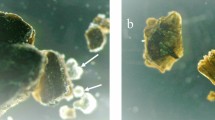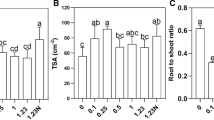Abstract
Main conclusion
Negatively charged carboxy-polystyrene (CPS) and positively charged amino-polystyrene (NPS) could significantly inhibit the biomass and flavonoid content of dandelion roots and leaves, and the inhibitory effect of NPS was stronger than that of CPS.
Abstract
The increasingly serious pollution of microplastics and heavy metals is likely to affect the efficacy of flavonoids synthesized by dandelion in natural medicine fields. Therefore, we combined hydroponic experiments with computational chemistry (Gaussian and autodock analysis) to explore the mechanism by which amino-polystyrene (NPS), carboxy-polystyrene (CPS), and lead affect the flavonoid biosynthetic pathway in dandelion (Taraxacum asiaticum Dahlst). Our results show that CPS and NPS could significantly inhibit the biomass and flavonoid content of dandelion roots and leaves, and the inhibitory effect of NPS was stronger than that of CPS. Mechanistic studies showed that CPS and NPS increased the content of O2− and H2O2 in dandelion roots and leaves, causing membrane lipid peroxidation, resulting in cell damage and decreased biomass. CPS and NPS inhibited related enzymatic activities by affecting their tertiary structures, resulting in a decrease in phenolic acid, coumaroyl-CoA, and flavonoid content. Dandelion preferred to absorb positively charged NPS compared to negatively charged CPS, but CPS inhibited the uptake of Pb by dandelion more strongly than NPS. Pb promoted CPS agglomeration and increased the surface positive charge of CPS through coordination bonds and hydrogen bonds, so more CPS entered dandelion under CPS + Pb treatment than under CPS alone. Although NPS and CPS reduced the uptake of Pb by dandelion, the biomass and flavonoid contents of dandelion were lower than those of single Pb treatment because of the higher toxicity of NPS and CPS than Pb. Pb significantly increased the effect of CPS on the root biomass of dandelion compared with CPS alone by increasing the positive charge of CPS. We suggest that microplastics with different charges and lead composite pollution inhibit dandelion flavonoid biosynthesis and provide a reference for the loss of dandelion medicinal components and economic value.





Similar content being viewed by others
Data availability
Data available within the article or its supplementary materials.
Abbreviations
- CAT:
-
Catalase
- CK:
-
Control treatment
- CPS:
-
Carboxyl polystyrene
- NPS:
-
Amino polystyrene
- MPs:
-
Microplastics
- PS:
-
Polystyrene
- 4CL:
-
4-Coumarate coenzyme
- CHI:
-
Chalcone isomerase
- CHS:
-
Chalcone synthase
- FNS:
-
Flavone synthase
- MDA:
-
Malondialdehyde
- SOD:
-
Superoxide dismutase
References
Banaee M, Soltanian S, Sureda A, Gholamhosseini A, Haghi BN, Akhlaghi M, Derikvandy A (2019) Evaluation of single and combined effects of cadmium and micro-plastic particles on biochemical and immunological parameters of common carp (Cyprinus carpio). Chemosphere 236:124335. https://doi.org/10.1016/j.chemosphere.2019.07.066
Barboza LGA, Vieira LR, Branco V, Carvalho C, Guilhermino L (2018) Microplastics increase mercury bioconcentration in gills and bioaccumulation in the liver, and cause oxidative stress and damage in Dicentrarchus labrax juveniles. Sci Rep 8(1):15655. https://doi.org/10.1038/s41598-018-34125-z
Cenkci S, Ciğerci İHM, Yıldız M, Özay C, Bozdağ A, Terzi H (2010) Lead contamination reduces chlorophyll biosynthesis and genomic template stability in Brassica rapa L. Environ Exp Bot 67(3):467–473. https://doi.org/10.1016/j.envexpbot.2009.10.001
Chen RZ, Li SZ, Liu CM, Yang SM, Li XL (2012) Ultrasound complex enzymes assisted extraction and biochemical activities of polysaccharides from Epimedium leaves. Process Biochem 47(12):2040–2050. https://doi.org/10.1016/j.procbio.2012.07.022
Dong YM, Gao ML, Qiu WW, Song ZG (2021) Uptake of microplastics by carrots in presence of As (III): combined toxic effects. J Hazard Mater 411(1):125055. https://doi.org/10.1016/j.jhazmat.2021.125055
Dong YM, Gao ML, Song ZG, Qiu WW (2019) Microplastic particles increase arsenic toxicity to rice seedlings. Environ Pollut 259:113892. https://doi.org/10.1016/j.envpol.2019.113892
Efremov RG (2019) Dielectric-dependent strength of interlipid hydrogen bonding in biomembranes: model case study. J Chem Inf Model 59(6):2765–2775. https://doi.org/10.1021/acs.jcim.9b00193
European Food Safety Authority (2010) Panel EFSA - Scientific opinion of the CONTAM Panel: Lead in food. EFSA J 8(4):1570–1717
Fischer S, Kühnlenz T, Thieme M, Schmidt H, Clemens S (2014) Analysis of plant Pb tolerance at realistic submicromolar concentrations demonstrates the role of phytochelatin synthesis for pb detoxification. Environ Sci Technol 48(13):7552–7559. https://doi.org/10.1021/es405234p
Habtemariam S (1997) Flavonoids as inhibitors or enhancers of the cytotoxicity of tumor necrosis factor-alpha in l-929 tumor cells. J Nat Prod 60(8):775–778. https://doi.org/10.1021/np960581z
Hassanvand A, Saadatmand S, Yazdi HL, Iranbakhsh A (2021) Biosynthesis of nanosilver and its effect on key genes of flavonoids and physicochemical properties of Viola tricolor L. Iran J Sci Technol Trans Sci 45:805–819. https://doi.org/10.1007/s40995-021-01091-7
Huang YM, Wu P, Ying J, Dong ZH, Chen XD (2021) Mechanistic study on inhibition of porcine pancreatic α-amylase using the flavonoids from dandelion. Food Chem 344:128610. https://doi.org/10.1016/j.foodchem.2020.128610
Jiang XF, Chen H, Liao YC, Ye ZQ, Li M, Klobučar G (2019) Ecotoxicity and genotoxicity of polystyrene microplastics on higher plant Vicia faba. Environ Pollut 250:831–838. https://doi.org/10.1016/j.envpol.2019.04.055
Kilci A, Gocmen D (2014) Phenolic acid composition, antioxidant activity and phenolic content of tarhana supplemented with oat flour. Food Chem 151:547–553. https://doi.org/10.1016/j.foodchem.2013.11.038
Kim JH, Baik SH (2015) Preparation and characterization of fermented dandelion (Taraxacum officinale) beverage using Lactobacillus acidophilus f46 having cinnamoyl esterase activity. Food Sci Biotechnol 24:583–593. https://doi.org/10.1007/s10068-015-0076-1
Korolenko SE, Kubasov AS, Goeva LV, Avdeeva VV, Malinina EA, Kuznetsov NT (2021) Features of the formation of zinc(II) and cadmium(II) complexes with the inner-sphere and outer-sphere position of the decahydro- closo -decaborate anion in the presence of azaheterocyclic ligands. Inorg Chim A 520:120315. https://doi.org/10.1016/j.ica.2021.120315
Li LH, Yi HL (2012) Effect of sulfur dioxide on ros production, gene expression and antioxidant enzyme activity in Arabidopsis plants. Plant Physiol Biochem 58(3):46–53. https://doi.org/10.1016/j.plaphy.2012.06.009
Li LZ, Luo YM, Peijnenburg WJGM, Li RJ, Yang J, Zhou Q (2020) Confocal measurement of microplastics uptake by plants. MethodsX 7:100750. https://doi.org/10.1016/j.mex.2019.11.023
Lu T, Chen FW (2012) Multiwfn: a multifunctional wavefunction analyzer. J Comput Chem 33(5):580–592. https://doi.org/10.1002/jcc.22885
Martinez M, Poirrier P, Chamy R, Prüfer D, Schulze-Gronover C, Jorquera L, Ruiz G (2015) Taraxacum officinale and related species—An ethnopharmacological review and its potential as a commercial medicinal plant. J Ethnopharmacol 169:244–262. https://doi.org/10.1016/j.jep.2015.03.067
Meng FR, Yang XM, Riksen M, Xu MG, Geissen V (2021) Response of common bean (Phaseolus vulgaris L.) growth to soil contaminated with microplastics. Sci Total Environ 755:1425166. https://doi.org/10.1016/j.scitotenv.2020.142516
Pehlivan N, Gedik K (2021) Particle size-dependent biomolecular footprints of interactive microplastics in maize. Environ Pollut 277:116772. https://doi.org/10.1016/j.envpol.2021.116772
Pérez-Dorado I, Galan-Bartual S, Hermoso JA (2012) Pneumococcal surface proteins: when the whole is greater than the sum of its parts. Oral Microbiol Immunol 27(4):221–245. https://doi.org/10.1111/j.2041-1014.2012.00655.x
Punamiya P, Datta R, Sarkar D, Barber S, Patel M, Das P (2010) Symbiotic role of Glomus mosseae in phytoextraction of lead in vetiver grass [Chrysopogon zizanioides (L.)]. J Hazard Mater 177(1–3):465–474. https://doi.org/10.1016/j.jhazmat.2009.12.056
Seregin V, Shpigun LK, Ivanov VB (2004) Distribution and toxic effects of cadmium and lead on maize roots. Russ J Plant Physiol 51(4):525–533. https://doi.org/10.1023/B:RUPP.0000035747.42399.84
Sharma P, Shukla B (2020) Lead bioaccumulation mediated by Bacillus cereus bps-9 from an industrial waste contaminated site encoding heavy metal resistant genes and their transporters. J Hazard Mater 401:123285. https://doi.org/10.1016/j.jhazmat.2020.123285
Sun JH, Xia SD, Ning Y, Xia P, Qu JH, Xu YJ (2019) Effects of microplastics and attached heavy metals on growth, immunity, and heavy metal accumulation in the yellow seahorse. Hippocampus Kuda Bleeker Mar Pollut Bull 149:110510. https://doi.org/10.1016/j.marpolbul.2019.110510
Sun XD, Yuan XZ, Jia YB, Feng LJ, Zhu FP, Dong SS, Liu JJ, Kong XP, Tian HY, Duan JL, Ding ZJ, Wang SG, Xing BS (2020) Differentially charged nanoplastics demonstrate distinct accumulation in Arabidopsis thaliana. Nat Nanotechnol 15(9):755–760. https://doi.org/10.1038/s41565-020-0707-4
Tanikawa N, Kashiwabara T, Hokura A, Abe T, Nakayama M (2008) A peculiar yellow flower coloration of camellia using aluminum-flavonoid interaction. J Jpn Soc Hort Sci 77(4):402–407. https://doi.org/10.2503/jjshs1.77.402
Wang ZZ, Fu DD, Gao L, Qi HY, Su YY, Peng LC (2021) Aged microplastics decrease the bioavailability of coexisting heavy metals to microalga Chlorella vulgaris. Ecotox Environ Safe 217:112199. https://doi.org/10.1016/j.ecoenv.2021.112199
Wehr B, Blamey FPC, Menzies NW (2010) Comparison between methods using copper, lanthanum, and colorimetry for the determination of the cation exchange capacity of plant cell walls. J Agric Food Chem 58(8):4554–4559. https://doi.org/10.1021/jf100097k
Wen FS, VanEtten HD, Tsaprailis G, Hawes MC (2007) Extracellular proteins in pea root tip and border cell exudates. Plant Physiol 143(2):773–783. https://doi.org/10.1104/pp.106.091637
Wen XF, Du CY, Xu P, Zeng GM, Huang DL, Yin LS, Yin QD, Hu L, Wan J, Zhang JF, Tan SY, Deng R (2018) Microplastic pollution in surface sediments of urban water areas in changsha, China: abundance, composition, surface textures. Mar Pollut Bull 136:414–423. https://doi.org/10.1016/j.marpolbul.2018.09.043
Williams DH, Stephens E, O’Brien DP, Zhou M (2005) Understanding noncovalent interactions: ligand binding energy and catalytic efficiency from ligand-induced reductions in motion within receptors and enzymes. Angew Chem Int Edit 43(48):6596–6616. https://doi.org/10.1002/anie.200300644
Wu WM, Yang J, Criddle CS (2017) Microplastics pollution and reduction strategies. Front Environ Sci Eng 11(1):1–4. https://doi.org/10.1007/s11783-017-0897-7
Yang FY, Yang TR, Liu K, Cui S, Wang RG, Li GJ (2019) Flavonoids metabolism and antimicrobial activity of Arabidopsis heterologous expressing CiRS gene. China Biotechnol 39(11):22–30. https://doi.org/10.13523/j.cb.20191103
Yoshimatsu K (2012) Innovative cultivation: hydroponics of medicinal plants in the closed-type cultivation facilities. J Trad Med 29:30–34. https://doi.org/10.11339/jtm.29.30
You Y, Yoo S, Yoon HG, Park J, Lee YH, Kim S, Oh KT, Lee JM, Cho HY, Jun WJ (2010) In vitro and in vivo hepatoprotective effects of the aqueous extract from Taraxacum officinale (dandelion) root against alcohol-induced oxidative stress. Food Chem Toxicol 48:1632–1637. https://doi.org/10.1016/j.fct.2010.03.037
Yu HW, Qi WX, Cao XF, Hu JW, Li Y, Peng JF, Hu CZ, Qu JH (2021) Microplastic residues in wetland ecosystems: do they truly threaten the plant-microbe-soil system? Environ Int 156:106708. https://doi.org/10.1016/j.envint.2021.106708
Zeng FR, Mallhi ZI, Khan N, Rizwan M, Alyemeni MN (2021) Combined citric acid and glutathione augments lead (Pb) stress tolerance and phytoremediation of castorbean through antioxidant machinery and Pb uptake. Sustainability 13(7):1–15. https://doi.org/10.3390/su13074073
Zhao BB, Wang L, Pang SY, Jia ZC, Wang L, Li WX, Jin B (2020) UV-B promotes flavonoid synthesis in Ginkgo biloba leaves. Ind Crop Prod 151:112483. https://doi.org/10.1016/j.indcrop.2020.112483
Zhao XY, Li B, Yang ZM, Teng Y, Liu Y (2015) Extraction and determination of total phenolic acids in Leontopodium franchetii at different harvest time. Chinese J Exp Trad Med Formulae 21(9):19–21. https://doi.org/10.13422/j.cnki.syfjx.2015090019
Zhou Q, Zhang HB, Fu CC, Zhou Y, Dai ZF, Li Y, Tu C, Luo YM (2018) The distribution and morphology of microplastics in coastal soils adjacent to the Bohai sea and the Yellow sea. Geoderma 322:201–208. https://doi.org/10.1016/j.geoderma.2018.02.015
Zhu ZJ, Wang HH, Yan B, Zheng H, Jiang Y, Miranda OR, Rotello VM, Xing BS, Vachet RW (2012) Effect of surface charge on the uptake and distribution of gold nanoparticles in four plant species. Environ Sci Technol 46:12391–12398. https://doi.org/10.1021/es301977w
Acknowledgements
This study was funded by the National Natural Science Foundation of China (Nos. 41877362), STU Scientific Research Foundation for Talents (No. NTF19026 and NTF19025).
Author information
Authors and Affiliations
Contributions
M.L. Gao and S.L. Wang preformed laboratory experiments. Y.M. Dong provided significant input on experimental design. Z.G. Song conceived of the idea of this study and provided partly financial means. L.S. Bai and T.B. Wang interpreted histological data. Y.M. Dong, M.L. Gao and Z.G. Song analyzed the data and prepared the manuscript, all authors contributed substantially to revisions.
Corresponding author
Ethics declarations
Conflicts of interest
The authors declare no conflicts of interest.
Additional information
Communicated by Dorothea Bartels.
Publisher's Note
Springer Nature remains neutral with regard to jurisdictional claims in published maps and institutional affiliations.
Supplementary Information
Below is the link to the electronic supplementary material.
Rights and permissions
Springer Nature or its licensor holds exclusive rights to this article under a publishing agreement with the author(s) or other rightsholder(s); author self-archiving of the accepted manuscript version of this article is solely governed by the terms of such publishing agreement and applicable law.
About this article
Cite this article
minling, G., Dong, Y., Wang, S. et al. Effect of co-toxicity of lead and nanoplastics on the flavonoid biosynthetic pathway in dandelion (Taraxacum asiaticum Dahlst). Planta 256, 94 (2022). https://doi.org/10.1007/s00425-022-04008-9
Received:
Accepted:
Published:
DOI: https://doi.org/10.1007/s00425-022-04008-9




